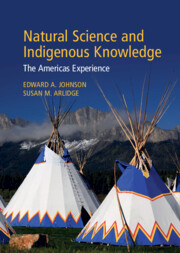Book contents
- Natural Science and Indigenous Knowledge
- Natural Science and Indigenous Knowledge
- Copyright page
- Contents
- Contributors
- Preface
- 1 What Do Indigenous People Have to Tell Us about the Cultural Landscapes They Have Created?
- 2 Reintegrating Cultural and Natural Landscapes
- 3 “My Uncle Was Resting His Country”: Dene Kinship and Insights into the More Distant Past
- 4 Native American Science in a Living Universe: A Paiute Perspective
- 5 “To Get More Harvest”
- 6 Hunting and Trapping in the Americas: The Assessment and Projection of Harvest on Wildlife Populations
- 7 On Fire and Water: The Intersection of Wetlands and Burning Strategies in Managing the Anthropogenic Plant Communities of Yosemite National Park
- 8 Indigenous Knowledge and the Kindergarten to Twelfth-Grade Science Classroom
- Index
- References
6 - Hunting and Trapping in the Americas: The Assessment and Projection of Harvest on Wildlife Populations
Published online by Cambridge University Press: 11 April 2024
- Natural Science and Indigenous Knowledge
- Natural Science and Indigenous Knowledge
- Copyright page
- Contents
- Contributors
- Preface
- 1 What Do Indigenous People Have to Tell Us about the Cultural Landscapes They Have Created?
- 2 Reintegrating Cultural and Natural Landscapes
- 3 “My Uncle Was Resting His Country”: Dene Kinship and Insights into the More Distant Past
- 4 Native American Science in a Living Universe: A Paiute Perspective
- 5 “To Get More Harvest”
- 6 Hunting and Trapping in the Americas: The Assessment and Projection of Harvest on Wildlife Populations
- 7 On Fire and Water: The Intersection of Wetlands and Burning Strategies in Managing the Anthropogenic Plant Communities of Yosemite National Park
- 8 Indigenous Knowledge and the Kindergarten to Twelfth-Grade Science Classroom
- Index
- References
Summary
Indigenous people in the Americas disproportionately depend on wild meat. Many approaches have been applied to assess the impact of hunting on wildlife populations by determining whether or not it can be defined as “sustainable.” Proper understanding of sustainability requires specification of what is being sustained, the spatial extent under consideration, the duration over which the resource is being sustained, and how the impact of a particular use compares with realistic forms of alternative uses. The sustainability of hunting is species specific with harvest-sensitive species often succumbing to depletion, while others persist indefinitely. Prey profiles of Amazonian hunters rapidly shift from low-fecundity and harvest-sensitive to high-fecundity and harvest-insensitive species as local human population density increases. This is a consequence of the life history of each hunted species, which dictates age at first birth, fecundity, and survivorship, and its “catchability,” which is a measure of the effectiveness of hunting effort. Here we review density-dependent population growth in wildlife and the implementation of harvest models typical to human central-place foragers to project wildlife populations in space and time rather than a binary assessment of whether hunting is “sustainable.”
Keywords
- Type
- Chapter
- Information
- Natural Science and Indigenous KnowledgeThe Americas Experience, pp. 176 - 200Publisher: Cambridge University PressPrint publication year: 2024



